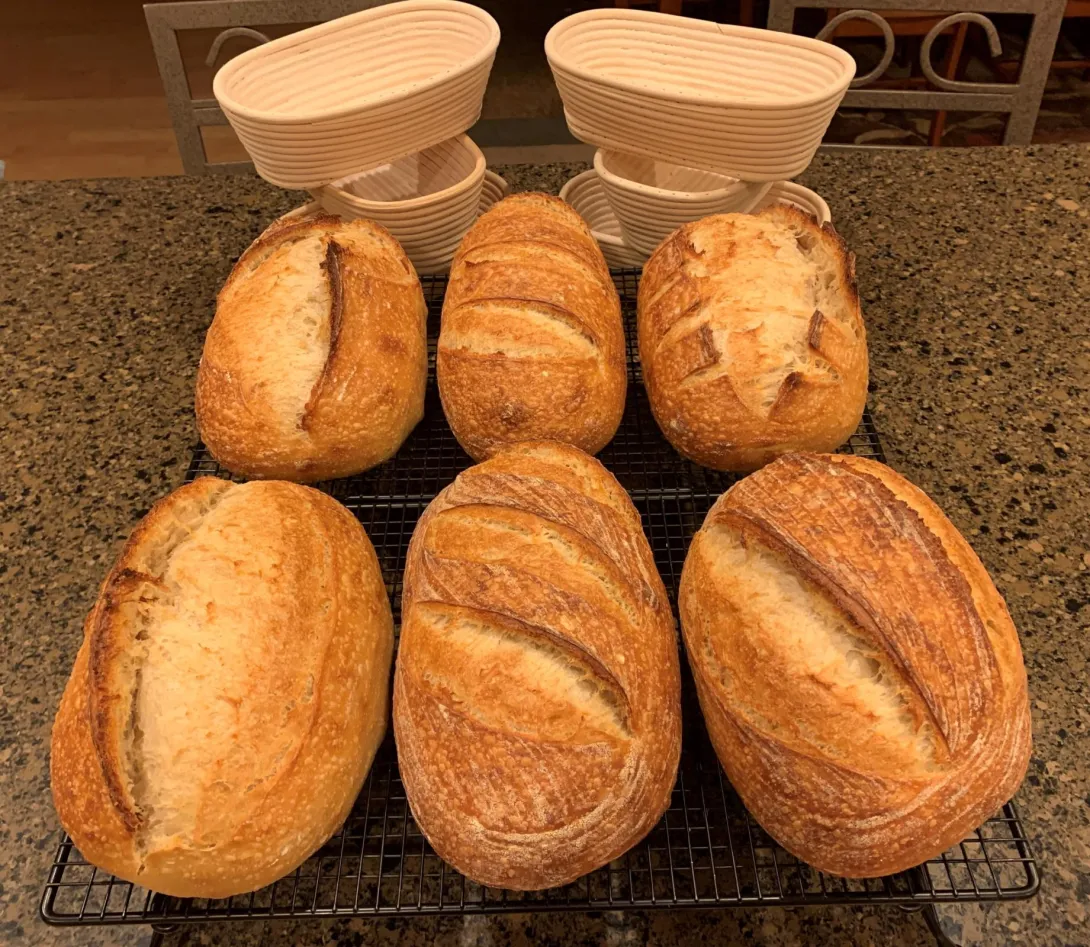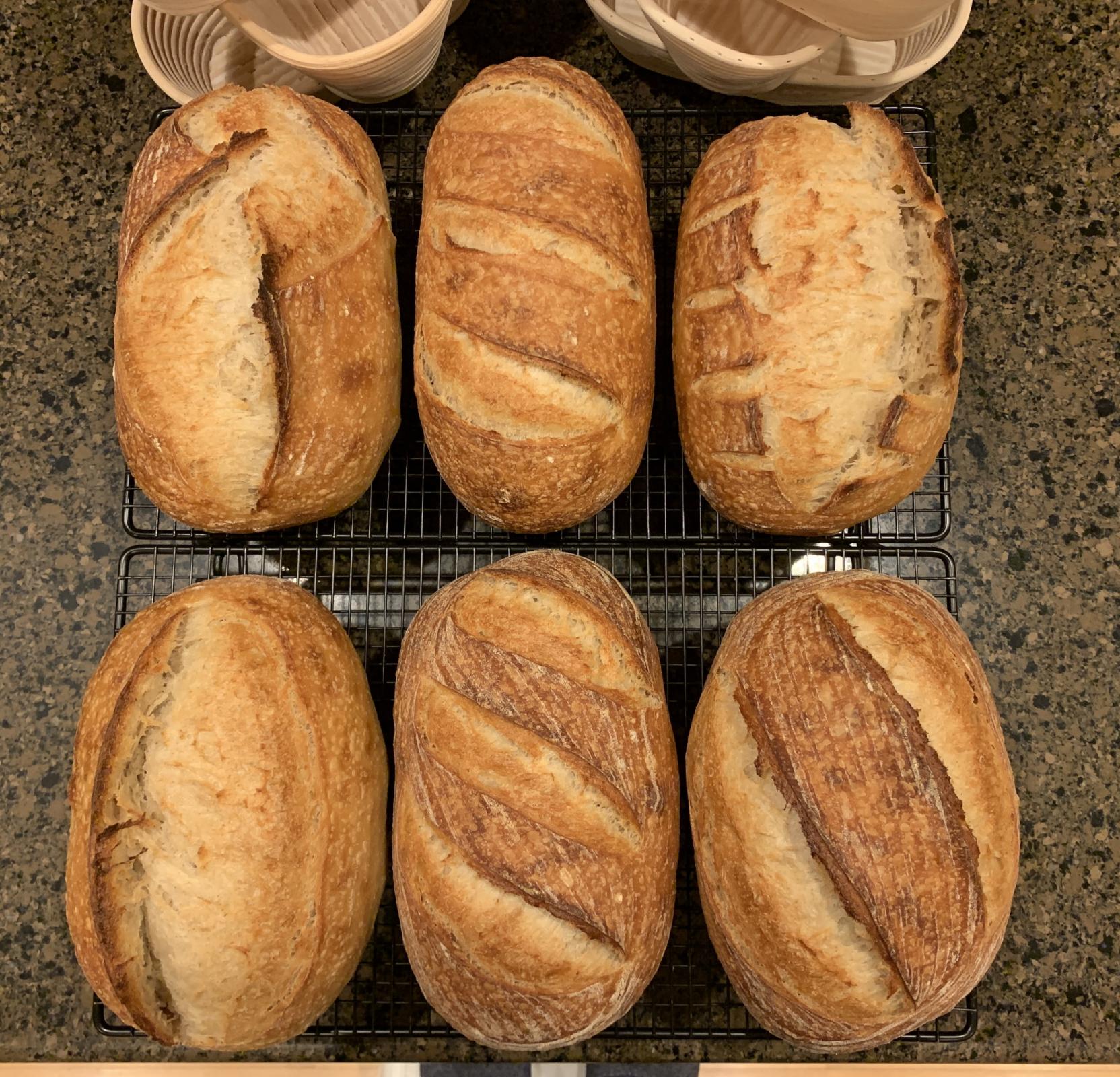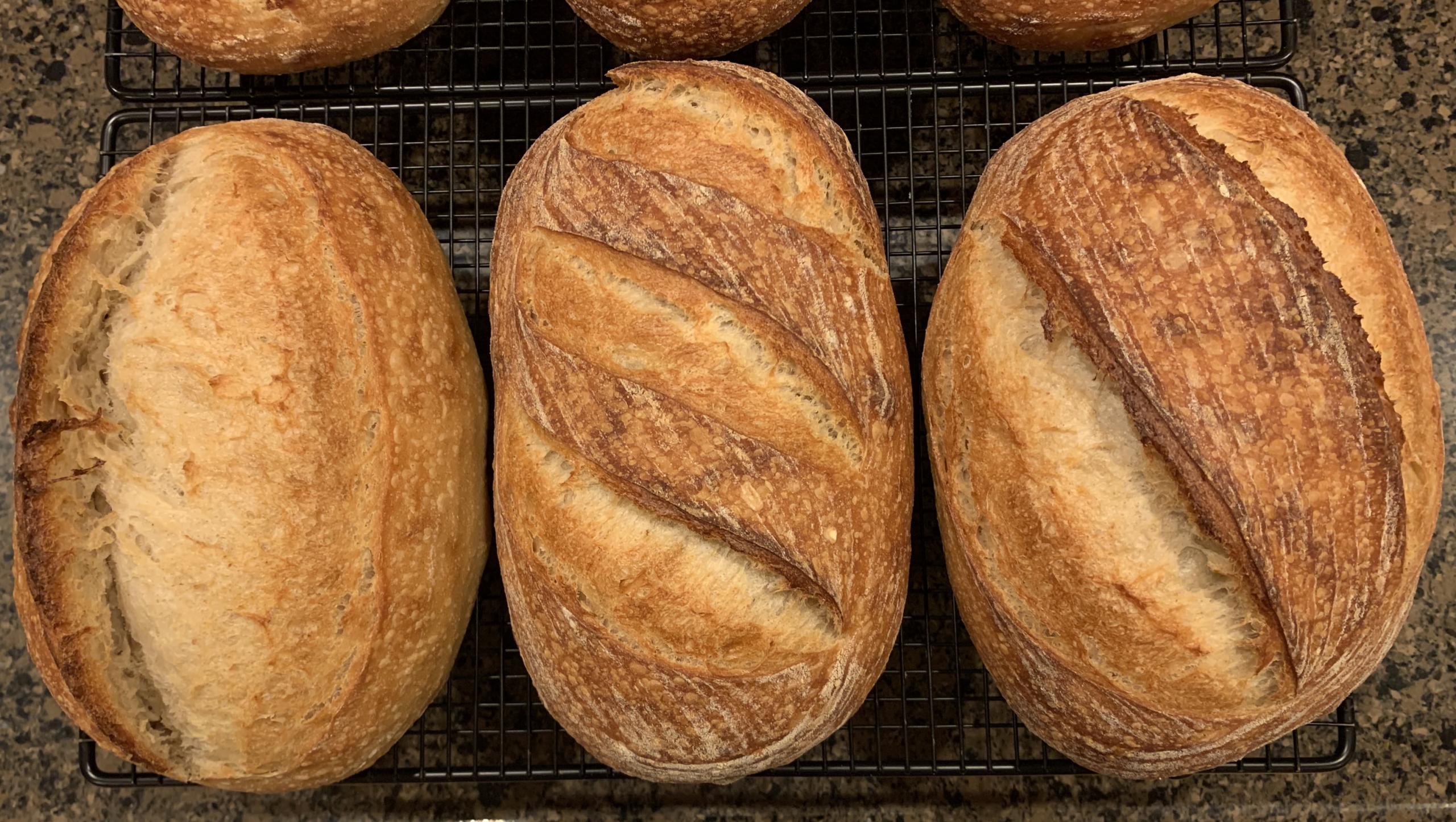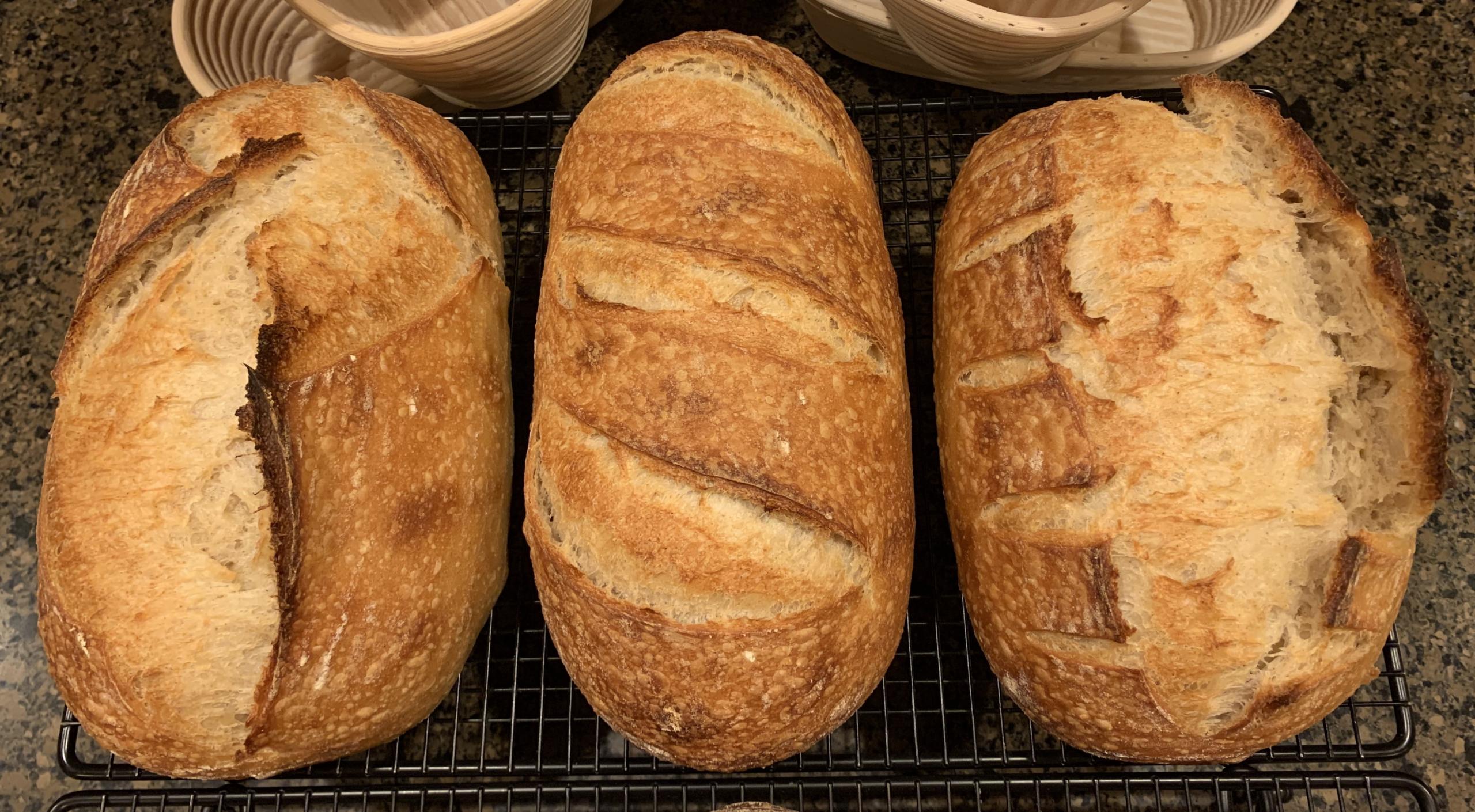
Today's bake used a small inoculation a long, slow bulk ferment. I wanted to see what kind of flavor I could build with my new starter and a little blueberry yeast water in a dough that was over 90% AP/Bread flour. I added just a little bit of whole grain for flavor and color. Wanted to get a crumb color that was a pale blonde.
Makes 1 loaf
247g AP Flour
169g Bread Flour
11g Whole Wheat Flour
11g Semola Rimicinata Flour
6g Rye Flour
6g Barley Flour
225g Water
68g Blueberry Yeast Water
9g Sea Salt
16g Starter
12g Honey
Method
Combine all ingredients and mix
Saltolyse for 60 minutes
2 sets of bowl kneading with a 45 minute rest between. Place in proofing box at 75 deg F.
Bowl stretch and folds every 90 minutes until dough starts to get puffy (3 sets for me)
Pre-shape in a boule and bench rest 20-30 minutes
Final shape and final proof. This method may have a long final proof (2-3 hours). Watch the dough and not the clock. It should be "jiggly".
Cold retard for up to 8 hours.
Bake at 450 deg F for 18 minutes with steam. Vent oven and reduce to 425 deg F for 10 minutes. Internal temperature should be 205 deg F.

Scoring and Loaf Shape

I experimented with different scoring because I had 6 "identical" loaves. I baked 3 at a time. For the first bake, I did a single center line score, three cross diagonals, and two long diagonals. The long diagonals started at the center end of the loaf and went about 3/4 of the length to the side. In all cases, the loaf opens perpendicular to the score. A loaf that's split along the center line tends to open out and get wide. A loaf scored multiple times across the loaf tend to open along the length. They stay the same general width but get longer (the loaf if the first bake was spreading just a bit before the score. Not a puddle but noticeably spreading, so I think a bit wider than a typical loaf). The long diagonals produced a loaf that was both a bit longer and wider, but was also a little "twisted" and produced a irregular shaped end to the loaf.
For the second three, I repeated the multiple cross loaf scores. I wanted to see if it would get longer without spreading like the first one. I also did two different scoring patterns that were a continuous score along the centerline (one zig-zag and one holding the lame at no angle with multiple short cross scores). In this case, the cross scores produced a loaf that was definitely longer and narrower. In both cases with the continuous center line scores, the loaf opened up and got wider without really changing in length.

Unfortunately, all these loaves were spoken for, so I can't say if there's any difference in the crumb.
What did I get out of it? I tend to like my bread to be uniform in shape. Call it the engineer in me. So, I think going forward my scoring will be long diagonals or multiple cross scores.
- HeiHei29er's Blog
- Log in or register to post comments
You can see that cuts across the middle are restricting but do make a more uniform narrow loaf. They look slightly longer too.
Have you any pictures right after scoring? (before and after shots)
Have you tried scoring somewhere between less across and lengthwise, more like a baguette with maybe two cuts and a thin strip of dough between? Scissors? Go wild! Have lots of fun.
Oh, I just had a wild idea.... while the dough is rolled out, run a pastry cutter or stamp cookie cutters thru the last half before rolling up. Leave a two inch border so that the seam can be pinched shut. Not sure if one should cut completely thru the dough layer or score just under the surface and if one should moisten dough before rolling up so everything sticks together. Depends on the dough. I'll know it when I get there.
You can see that cuts across the middle are restricting but do make a more uniform narrow loaf. They look slightly longer too. - they are definitely longer, especially in the second batch. That first one was spreading a bit right out of the banneton, so I think that was the biggest contributor to it getting wider. With that scoring pattern, the "straps" hold the two sides of the loaf together while it is free to expand lengthwise.
Have you any pictures right after scoring? (before and after shots) - no, and I'm kicking myself for that. Here's a graphic that corresponds with the overhead picture and shows more or less how each loaf was scored. The zig-zag pattern had a short (1-1.5") score that was straight on each end. That kept the ends of the loaf squared off instead "twisting" like the diagonal score in the first batch. In all cases, the patterns below were in the top, flat portion of the loaf after coming out of the banneton. I didn't do any scoring that went down the sides of the dough.
Have you tried scoring somewhere between less across and lengthwise, more like a baguette with maybe two cuts and a thin strip of dough between? Scissors? - none of the above. I haven't tried making baguettes yet. I'll have to look at how they're scored.
Cookie cutters is an interesting idea! I think you could get it in and out if you wet it before-hand, especially with a lower hydration dough. I think you could get it to stick easy enough. Too many ideas and things too try. :-)
Very cool thanks for sharing this.I am curious like Mini about baguette style vertical parallel slashes... because your experiment suggests that horizontal slashes miht keep a more narrow loaf shape. Hm.
I am also interested in the smaller inoculation and longer retarded proof. Did you see a difference? My dough goes nuts in the fridge since I started doing yudane in it and I have been thinking about scaling back my levain significantly. (you can see the before and after dough size in my latest blog)
I’ll check into the baguette scoring and see if I can do another comparison.
I would say the biggest difference is flavor. The long fermentation helps develop more complex flavors. I always try to achieve more of a sandwich loaf type crumb instead, so I can’t comment much on any differences in crumb.
Abe taught me this method, and it’s still one of my go to approaches. If you want to try it, I’d start with a 3.5-4% starter inoculation (based on total flour) and a 65-70% hydration dough. Mix, autolyse 45-60 mins, use your favorite approach to get medium gluten development (kneading, French Folds, etc.), bulk ferment at 72-75 deg F with S&F every 60-120 minutes until the dough is just getting puffy (for me that’s about 7-9 hours from the initial Mix), let dough increase 70-80% before ending bulk. For final proof, watch the dough. Let rise until “jiggly”. If final proof is going fast with the yudane, you’ll have to judge when you want to cold retard. Depending on my schedule and timing, my cold retard is 2-8 hours.
Good luck!
This is really helpful. Part of why I nearly always bake sandwich bread in a loaf pan these days is for the more uniform shape. Hubby prefers that, and it's easier to make sandwiches, toast, etc. when the bread fits into the toaster slot or baggie. I'll have to break out of my current rut and play with scoring a bit.
Thanks!
Mary
Try scoring one almost straight across like the middle, top loaf. It stayed very uniform, and it's oven spring was just as tall as the other loaves. It would make perfect sandwich bread. You could probably even add 1 or 2 more scores along the length.
Seeing the crumb would have been interesting. Maybe next time.
Agreed. Might just have to give everyone a sliced open loaf next time. :-)
So this time, I took it to the extremes. One loaf with multiple vertical slashes and one loaf with multiple horizontal slashes. The difference in loaf shape is definitely there and reproduces what I saw last weekend. However, no significant difference in crumb. Each loaf is sliced right down the middle. Still doing something to capture air bubble during bulk or shaping though. Need to work on that...